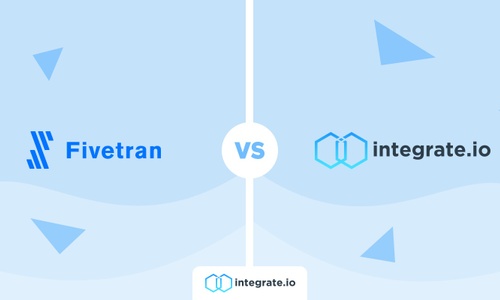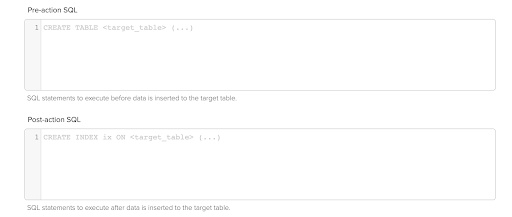Fivetran and Integrate.io are cloud-based data integration platforms that pull data from different sources and push it into the most popular data warehouses and database systems such as Oracle Database, PostgreSQL, and MySQL. Both Fivetran and Integrate.io feature visual, point-and-click interfaces and extensive selections of pre-built connectors that make customizing workflows and third-party apps simple. However, the differences between these platforms are significant.
Here are three of the most important areas of difference:
- ELT vs. ETL: Fivetran is an ELT platform that performs data transformations after loading information into the destination. Integrate.io is an ETL and ELT platform that performs data transformations either before or after loading. ELT functions benefit large scale or enterprise endeavors and allow them the option to store and transform data at will with the ability to organize and store freely. In terms of versatility, Integrate.io allows its customers to select the option that works best for their needs rather than having them commit to ETL data transformation.
- Consumption-based pricing vs. flat-rate pricing: Fivetran uses a consumption-based pricing model that charges by the volume of data consumption. This is why Fivetran is better suited for those customers who have low-volume needs. The cost is reasonable if data consumption is less than large to enterprise-level companies. Integrate.io uses a flat-rate pricing model that charges per connection, so monthly expenses stay constant and predictable regardless of data volume. This plan pricing means that large companies with high volume needs can select the connection and options they need. In turn, they keep predictable pricing to help them reduce budget requirements and get the flexibility and performance they need for daily processes and data transfers.
- Skill level requirement: While Fivetran is easy to use for extract/load operations, setting up data transformations will require SQL knowledge. This might mean having a developer or extra IT personnel to handle these operations, which drives up the overall cost for the company. Integrate.io allows users without any coding skills to develop automated transformations, enabling the entire company (marketing, business analysts, and developers) to use the platform. Integrate.io also offers a native scripting language and SQL editor for more nuanced transformation operations. The entire connection process only takes a few minutes and is ready to perform via a user-friendly dashboard. Ultimately, a company saves on charges based on volume and doesn't need an expert to perform and create those connections and functions, which reduces workforce and labor needs to help save even more.
In this detailed comparison, we'll examine these and other differences between Fivetran vs. Integrate.io, so you can determine which integration platform is best for your needs – both now, critically, in the future. Remember that you want to choose the service that can help you scale your business and provide the most options for a growing and changing company.
Overview of Fivetran and Integrate.io
We'll start with a brief overview of Fivetran vs. Integrate.io.
Fivetran
Fivetran began in 2014 as a cloud-native data integration solution that provided extract/load capabilities for easy integrations between popular data sources and destinations. In mid-2019, Fivetran added data transformations tools, which elevated it from an "EL" only solution to a full-fledged ELT platform. Although Fivetran still cannot perform pre-load ETL transformations, it is still a capable and respected ELT solution.
As an "easy-to-use" ELT platform, Fivetran empowers users without much ETL experience to set up basic extract/load processes quickly and cost-effectively. However, to take advantage of Fivetran's transformation capabilities, users need to have SQL coding skills. Fivetran does offer pre-built SQL models, however. These options use dbt, which reduces the development process to make using their services easier and more flexible.
As we will discuss in further detail below, Fivetran uses a consumption-based pricing model. It also relies on the computing power of your destination data warehouses to perform data transformations. This makes Fivetran an excellent match for companies with low-volume data demands that want to develop simple, uncomplicated ELT pipelines.
Integrate.io
Integrate.io launched in 2011 as a cloud-native ETL platform with an easy-to-use, no-code, point-and-click user interface. Integrate.io's ease of use eliminates the need for a skilled development team to set up advanced ETL processes. At the same time, the platform doesn't sacrifice any of the power and capabilities of an enterprise-grade ETL solution. They offer a wide range of options from cloud-based services, platforms, connectors that provide the ideal level of security, transparency, and user-friendly features.
Integrate.io's wide range of pre-built connectors, two-way Salesforce-to-Salesforce integrations, drag-and-drop transformation tools, and flat-rate, per-connector pricing structure mean that it can satisfy your exact data integration requirements at an extremely competitive price-point. Unlike ETL platforms with similar capabilities, Integrate.io doesn't require the additional expenses of hiring a data engineer, paying for hosting, or the need to buy additional computing power. The customer simply chooses the connector they want to deploy. They can have the connection created via APIs in a few clicks without waiting for a professional to complete the project. Once the connection is made, the customer has access to a streamlined, reliable method for transferring data with the ability to control the process at any point.
While Fivetran was designed for firms with low-volume data requirements, Integrate.io was built for enterprises that need to pipe massive volumes of data from numerous sources while performing complex, in-pipeline data transformations. Also, Integrate.io was created to eliminate the extensive training requirements, barriers of entry, and auxiliary costs of comparable solutions so that anyone from the CEO's executive assistant to a graphic designer on the marketing team can set up specialized ETL workflows.
After this brief overview, let's take a deep dive into the differences between Fivetran and Integrate.io from the most important comparison areas.
Pre-Built Connectors/Integrations
Fivetran and Integrate.io offer similar ranges of pre-built connections. The difference is that when it comes to an uncommon source/destination, Integrate.io's support team is always available to help you establish the connection and design the necessary transformations.
Fivetran: 100+ Connectors
Fivetran offers 100+ ready-made integrations for virtually any source/destination. It also includes a "Function connector" so developers can code custom data connectors. This is useful when you want to connect to a unique REST API that isn't on Fivetran's list of pre-built connectors.
Here's a sample of Fivetran's pre-built connectors:
Integrate.io: 100+ Connectors
Integrate.io features 100+ pre-built connectors for the most popular sources and destinations, including the most popular data warehouse systems. The platform also offers a native REST API connector so that you can integrate data to and from uncommon sources/destinations.
Here’s a sample of Integrate.io’s pre-built connectors:
If you're struggling with an uncommon source/destination, Integrate.io's team of integration specialists is always available to help you design custom integrations with Integrate.io's REST API connector. In fact, the Integrate.io team has access to a large database of previously-created custom connections that they can replicate if you need to connect with a similar source.
Salesforce Integrations
Fivetran and Integrate.io's Salesforce connectors differ because Fivetran has a one-way salesforce connector, and Integrate.io features two-way, Salesforce-to-Salesforce integrations.
Fivetran: One-Way Salesforce Connector
One of Fivetran's most celebrated connectors is its native Salesforce integration. This easy-to-set-up integration efficiently extracts data from your Salesforce account and loads it into your data warehouse for analysis. Like most easy-to-use ELT platforms, Fivetran's Salesforce integration is "one-way," so it does not allow you to transform Salesforce data in-pipeline and load it back into Salesforce.
Integrate.io: Two-Way Salesforce-to-Salesforce Connector
One of Integrate.io's most popular connectors is its two-way Salesforce-to-Salesforce connector. This feature – which Fivetran does not include – allows you to extract Salesforce information, transform it within Integrate.io's data engine and load it back into Salesforce and can perform Salesforce-to-Salesforce integrations. Integrate.io makes these tasks easy to set up for a portion of the cost.
Pricing Structure
Fivetran uses a consumption-based pricing method while Integrate.io uses a flat-rate, connector-based pricing method.
Fivetran: Consumption-Based Pricing
Fivetran charges based on consumption, so the more data rows you consume, the higher the cost of using the platform. This works well for organizations with minimal data demands, but if you scale into the high-volume territory, the high price of Fivetran's consumption-based fees will soon become impractical.
Consumption-based pricing also poses a challenge for budgeting. Since your data consumption can skyrocket and decline depending on monthly requirements, you may find that it's impossible to predict how much your data integration costs will be from month to month and year to year.
Integrate.io: Flat-Rate, Per-Connection Pricing
Integrate.io pricing is tailored exactly to each client's needs and requirements with a usage-based component couple with features and functionality. Clients choose which level of platform usage they will require and then which features and functionality to create a custom plan to fit their use case.
Click this link to try Integrate.io's no commitment 2-week trial program (no credit card required).
ETL vs ELT
Fivetran is an ELT-only solution, while Integrate.io is an ETL solution that can also manage ELT processes if desired.
Fivetran: ELT Only (No In-Pipeline Data Transformations)
Fivetran takes advantage of the immense processing power of modern data warehouses, which can handle complex, large-volume transformations. Instead of performing transformations in its own data engine, Fivetran uses your cloud data warehouse to carry out SQL-coded transformations after loading.
Post-load transformations are fine if you're dealing with a small dataset, but it's important to remember that you will need to pay for the compute power required to perform those transformations.
According to Red Pill Analytics:
"SQL statements in Fivetran are executed using a "push-down" technique, sending SQL to the target warehouse and allowing the statement to be processed using compute provided by the target warehouse... Fivetran takes advantage of their customer's investment in cloud data warehousing."
Fivetran performs data transformations by siphoning processing power from your data warehouse. Essentially, it piggybacks onto your data warehouse, which is the only way Fivetran can offer low prices. They pass the cost onto you by increasing your data warehouse bill. This isn't a problem you're dealing with low-volume data ingestion. However, if your data demands scale into "big data" territory, Fivetran's consumption-based pricing and your data warehouse processing costs will skyrocket to unaffordable levels.
Integrate.io: ETL and ELT (In-Pipeline Data Transformations)
Integrate.io is an ETL platform that performs in-pipeline (pre-load) transformations within its powerful data engine while your data is in transit to the destination. The platform can also manage post-load transformations (ELT); however, Integrate.io's true advantages are realized when you allow the platform to provide the compute power for large-volume transformations at no additional cost.
Due to Integrate.io's flat-rate pricing structure, you can perform complex, in-pipeline transformations without incurring additional processing fees – which makes the platform extremely cost-efficient when managing integrations for large datasets.
Skill-Level Requirement
Both Fivetran and Integrate.io were built to be intuitive and easy to use. The main difference is that Fivetran requires SQL skills to set up transformations. While Integrate.io offers SQL coding tools for developers who want that flexibility, the platform doesn't require users to have any coding knowledge at all.
Fivetran: SQL Coding Skills Required
When setting up automated data transformations on Fivetran, developers need to code the transformations in SQL. Fivetran provides cut-and-paste SQL code snippets, which speed up and simplify the coding process considerably.
Users with SQL skills will find Fivetran's UI easy to operate when developing transformations. Nevertheless, you will require SQL knowledge to operate the platform successfully.
As we described above, Fivetran's transformation capabilities were introduced recently in mid-2019. Here's how Red Pill Analytics described these features not long after they were released:
"The new transformation layer allows creating and saving custom SQL statements to be run against the data warehouse. No longer solely focused on extracting and loading data, adding the transformation functionality rounds out a full extract-load-transform (ELT) offering."
Here's a screen capture of Fivetran's UI for SQL transformations:
Source: Fivetran Youtube Channel
Integrate.io: No Coding Skills Required but SQL-Editor Is Available
In achieving its goal of being an ETL platform that anyone – regardless of their ETL experience and tech knowledge level – can use to build complex data pipelines, Integrate.io has not sacrificed any of the powers and capabilities of an enterprise-grade ETL solution.
To facilitate the process of building complex data transformations without any coding skills, Integrate.io offers 100+ out-of-the-box transofrmations (including FILTER, SELECT, JOIN, CLONE, LIMIT, and more). These no-code transformations empower anyone to automate the kinds of data transformations and workflows that once were the domain of data engineers only.
More sophisticated ETL engineers will find that Integrate.io's native scripting language offers all of the advanced customization opportunities they need. Plus, all of Integrate.io's data warehouse and database destination connectors have the option of adding SQL to run before/after the data gets loaded into the destination. This allows you to increase your data sophistication and "future-proof" your ETL processes to support the continued future growth of your company.
Users with SQL knowledge will find Integrate.io's SQL editor very intuitive to operate. It's literally the best of both worlds.
Here's a high-speed look at creating an ETL workflow from Salesforce to Redshift in Integrate.io. At normal speed, the entire process takes about three minutes:
Check out Integrate.io's Youtube Channel for more helpful videos!
Integrate.io’s SQL editor for hand-coding in-pipeline and post-loading transformations:
Here’s what reviewers say about Integrate.io’s no-code UI:
“There are mostly two types of ETL as a service on the market: one is super easy to use and can migrate your data across services and databases but lacks transformation capabilities, while the other needs full-time data engineers to operate but tailored solutions are available programmatically. Integrate.io sits in the golden middle letting analysts and engineers deploying custom transformation jobs in minutes even based on multiple data sources.”
“Integrate.io is on PAR with enterprise-level tools.”
Customer Support
Both Fivetran and Integrate.io offer user support to all service level commitments.
Fivetran: Unlimited Customer Support for All Service Levels
Fivetran offers free customer support to all of its service-level commitments. However, bypassing support delays and getting a faster response time requires a subscription to Fivetran's most expensive service tier.
After reviewing numerous customer reviews, we found a common theme: Fivetran's support team takes a long time to address user concerns. Customers are often left waiting in the dark, wondering if they'll ever find a solution.
Here’s what users say about Fivetran support:
“Fivetran's customer support is not very helpful as you have to constantly reach out to them for updates. On occasions, it takes them days to reply on threads or provide plausible updates. Fivetran sales team provided great support for 15 days before purchasing the product. But once the contract was signed that level of support was nowhere to be found. Customer support is an essential service when buying into ingestion tools, especially at the premium price of Fivetran. But Fivetran fails to follow-through on scalability and customer support, from our experience.”
"It is good. But sometimes, the speed of customer service to reply is slow. They cannot help us as soon as possible."
“The support folks, while knowledgeable, must be swamped. There are times where there is an immediate issue but response times take hours. This has caused us to run fire drills to try and fix an issue when it was due to something on Fivetran's side, but we didn't get confirmation of it until a few hours later.”
Integrate.io: Unlimited Phone and Video Support for All Service Levels
Integrate.io includes a highly-responsive customer support team that’s available to all service-level commitments. It doesn’t matter if you’re paying for two connections or a thousand. If you’re an Integrate.io customer and need help creating an integration or automated transformation workflow, Integrate.io’s integration specialists are always just a phone call away.
In fact, Integrate.io views its support team as the key to achieving its goal of providing an ETL platform that anyone can use for high-volume data ingestion and data transformation. When you join the Integrate.io family, not only do you gain access to the most advanced ETL solution on the market, but you also get paired with a new essential member of your team: Your dedicated Integrate.io integration specialist.
The high level of satisfaction with Integrate.io’s awesome support team stands out in user reviews:
“When there is no native connector, the REST API connector will achieve the result we want, and the support team is always ready to jump in and help if needed. I also like the fact that the support team and comprehensive documentation are often focussed on helping you learn to achieve the result you want rather than doing the job for you. This has helped us leverage the learnings for other uses.”
“What we love best about Integrate.io is the near real-time support we get from the team. Integrate.io's point of difference is the customer support we receive. The product itself is good. Easy to use at a high level. The people at Integrate.io are the difference – which is unusual for Cloud proposition. A nice change from dealing with a faceless machine.”
Integrate.io support is accessible via email, phone, and video conference, and it’s incredible. Your dedicated Integrate.io integration specialist will feel like a member of your team who is always available to take the reins and set up the ETL process you require.
Monitoring/Logging
Fivetran does not include monitoring or logging within its UI, which is a significant departure from Integrate.io. Integrate.io’s UI includes advanced monitoring and logging tools for progress updates and troubleshooting.
Fivetran: No Monitoring/Logging in the UI
Fivetran’s UI doesn’t offer monitoring/logging information – like data loading progress estimates, etc. – for pending and completed jobs. For this reason, some users describe Fivetran as a “black box.” This lack of monitoring/logging transparency makes troubleshooting difficult, so users are forced to implement a third-party solution (which may represent an additional expense). Many set up backend logging through Amazon AWS.
Here’s what Fivetran users have to say about monitoring/logging:
“There's little to no progress estimate on the front end UI to see how long this refresh might take and you need to enable backend logging in Amazon to see where it's at in the sync process and derive rough estimates of completion time.”
"You aren't completely in control. Fivetran is a black box, and when there is a problem, it's really difficult to diagnose. Their support line is no prize, either."
“No internal logs. Have to use third-party tools.”
Integrate.io: Advanced Monitoring/Logging Features within the UI
Integrate.io’s UI allows you to monitor currently-running jobs and previously-executed jobs within the platform. You can monitor jobs on clusters in the dashboard, on a single cluster’s page, by using webhooks, or by polling the API. The Integrate.io UI displays interactive data that you can click for more details.
Integrate.io’s monitoring/logging features display the following details:
- Job ID
- Package name
- Cluster name
- Data submitted
- Team member who performed the action
- Current job status: idle/pending/running/done/failed/stopped/etc.
- Job progress percentage
- Job errors/failures
- Many other details
Integrate.io gives a summary view of pending and completed jobs that you can click for additional details:
Who Should Use Fivetran?
Fivetran’s ELT platform is most appropriate for organizations with simple, low-volume data integration needs. In fact, Fivetran appears to have specifically designed its platform to serve this use-case, and it is particularly adept and cost-effective at achieving what small-volume integrations require.
Here’s how Fivetran supports this use-case:
- Consumption-based pricing: Fivetran’s pricing – which charges based on the number of rows you consume – rewards organizations with smaller data demands. However, as you scale upward to massive data sets, this pricing model becomes impractical.
- Post-load transformations: Fivetran performs data transformations within your data warehouse, which means that you pay the processing (compute) costs. With Fivetran's new pricing model, this means that their pricing is favorable for low-volume integrations. This is fine if you’re not ingesting a lot of data. However, both your Fivetran and warehouse compute costs will skyrocket as your data volumes grow and you start processing millions of rows of data each month.
- Lack of monitoring in the UI: Fivetran’s lack of monitoring/logging features in its UI suggest that the platform is better suited for small, fast extract/load operations as opposed to large-scale uploads that could take hours or days to complete. If your data uploads in a minute, tracking progress isn’t essential. If it takes hours to upload, then you really want to closely monitor what’s happening.
At the end of the day, larger enterprises and rapidly-growing startups could face challenges with Fivetran due to its volume-based pricing structure, which (1) makes high-volume data integrations expensive and impractical, and (2) makes monthly budgeting impossible to predict. That being said, if you have someone on your team who can code SQL transformations, Fivetran offers a solid, easy-to-use ELT solution for businesses with low data requirements that don’t require in-pipeline transformations.
Here’s what users say about Fivetran’s challenges with high-volume data:
“A full schema refresh takes us 2-3 days and knocks us offline from monitoring up-to-date business KPIs, running updated analyses, etc. This is likely due to us having massive amounts of data (from a count(1) perspective, not size of tables perspective).”
“Fivetran is not scalable for large datasets when it comes to binary log syncs. We have run into problems from day 1, as we have 100s of GB worth data to be synced from a single connector every day. It has been over a month since the issue was first identified on Fivetran's end but there is no resolution in sight or even a timeline to resolve the issue.”
Who Should Use Integrate.io?
Integrate.io was designed for (1) organizations that need to build high-volume data integrations and complex data transformation workflows; and (2) organizations that want an easy-to-use ETL solution that empowers anyone – regardless of their tech experience – to connect any data source to any destination.
Here’s how Integrate.io supports this use-case:
- Flat-rate pricing: Integrate.io’s flat-rate pricing offers a predictable, easy-to-budget structure that allows you to scale the volume of your integrations to virtually any size – while performing complex in-pipeline data transformations on large datasets – without incurring additional costs.
- In-pipeline transformations: Integrate.io’s ability to manage in-pipeline transformations within its powerful data engine before the data loads into the destination reduces compute costs on your end. By eliminating these auxiliary processing costs, Integrate.io further supports a cost-effective, predictable, and easy-to-budget pricing model for large volume ingestion.
- Advanced monitoring: Integrate.io puts the monitoring/logging information you need at your fingertips for easy troubleshooting and disaster prevention. These metrics provide real-time data on the progress and projected completion times for large data integrations, and a great deal more information to dive deeper into problems.
- Highly-responsive customer support: The Integrate.io support team is always there to hold your hand and take the reins. This is especially helpful when a team member is new to ETL and doesn’t understand much about data integration.
Integrate.io’s utility, power, flexibility, ease-of-use, and cost-efficiency shine when you’re managing large volume ETL processes but don’t want to incur the overhead, steep learning curves, and massive auxiliary costs associated with a megalithic ETL platform like MuleSoft, Talend, or Jitterbit.
Here’s one user describes Integrate.io:
“After evaluating 10 or so ETL providers I went with Integrate.io because their service has a relatively straightforward GUI, but also allows for a fairly sophisticated level of configuration. Most of the time the GUI is sufficient, but I'm also able to script bits and pieces and add custom SQL to handle the weird edge cases or make some of the large transfers more efficient (e.g. using a custom date field). I'm also able to do data transformations as part of the pipeline.”
Final Thoughts on Fivetran vs Integrate.io
Let's finish this comparison with an analogy for Fivetran vs. Integrate.io. Imagine you need to buy a vehicle for your morning commute. It has to carry yourself, your kids, and several kids from the neighborhood, who you'll drop off at school.
Are you going to choose the two-seater Smart Car or the eight-seater Toyota SUV?
You'd choose the SUV because (1) it's big enough to handle your volume of kids, (2) it's got plenty of room to grow; and (3) it's more durable and reliable, and (4) it's got impressive bells and whistles for an easier, more comfortable ride.
Fivetran is like the Smart Car – an affordable, efficient solution if you don't have to transport a lot of data. Integrate.io is like the Toyota SUV – a large-volume, durable, enterprise-grade ETL platform with unlimited room to grow and all the advanced capabilities and future-proofing you could want.
While Fivetran is appealing for some business endeavors, if you expect your needs to grow or change in the future and want an economical and sensible alternative that gives more capability and features without the need for a developer or coding experience, Integrate.io is the way to go.
If you want a flexible, easy-to-use ETL solution that can scale with your organization and expertly meet your high-volume data demands, reach out to Integrate.io. Schedule a call with an Integrate.io integration specialist and experience Integrate.io for yourself.














